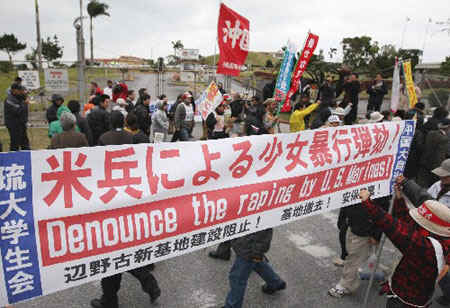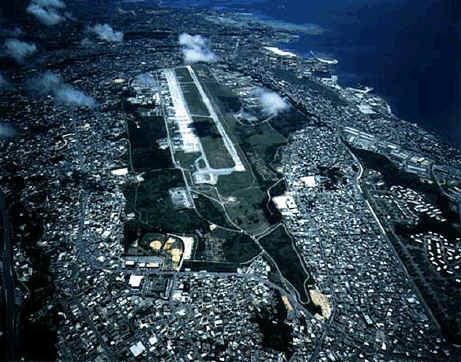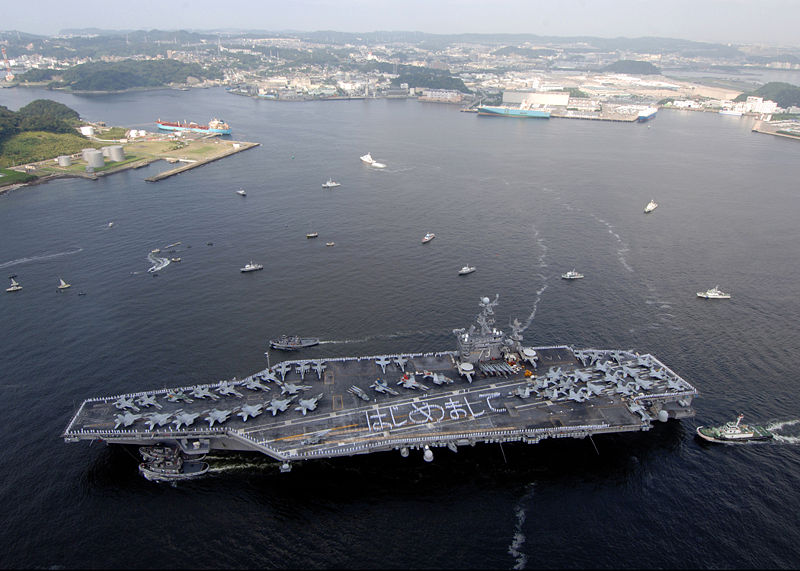|
Japan
is one of America’s closest allies, yet this relationship is threatened by a refusal to
accommodate reasonable demands from the Japanese people to close outdated
American military bases. During the Cold War, the USA
maintained some 50,000 military personnel in
Japan
to help defend that nation from the
Soviet Union
and Communist China. Those threats are mostly gone, while Japan
now fields a first-rate military that can defeat any threat. As a result,
the Japanese people are less tolerant of the noise and crime produced by large
American military bases. President Obama must close some bases before the new Japanese
nationalist government demands that all American GIs leave
immediately.
While Americans worry that
North Korea
may build a missile that can strike the USA, it has dozens of missiles that can reach Japan. Persistent American saber rattling with North Korea worries the Japanese,
especially those living near American military bases that are prime targets
should North Korea decide to strike, or ideal retaliatory targets should the USA
decide to bomb North Korea. Another source of friction is that Japan
has a very low crime rate and the presence of thousands of young American GIs
result in numerous robberies, assaults, rapes, and murders of Japanese citizens each
year. Finally, Japan
is densely populated while American military bases occupy large tracts of land
in urban areas that are frequent targets of complaints and lawsuits because of
loud aircraft.
The U.S.
military operates six major airbases in Japan, the same number
as when the Cold War ended. As the
U.S.
military shifted focus to the Persian Gulf and constructed a dozen of new
airbases in that region, it did not close any bases in Japan, even though their rationale dissipated. This is a waste of American money and
manpower, which irritates the Japanese since they help fund America’s massive fiscal deficit with the purchase of U.S. Treasury bonds.
Most Japanese were born after 1945, and the rest were just
children during World War II. They had no responsibility for that war and refuse
to accept a perpetual occupation of Japan
by foreign troops. All these factors have worsened relations and resulted in
frequent street protests. Visits by American nuclear-powered warships always
angered many Japanese. To make matters worse, last year the U.S. Navy
permanently based a nuclear-powered aircraft carrier at its base near Tokyo. Promises to close some bases never materialized as
American Generals and Admirals consider them American property.
Benefits from Downsizing
The irony is that closing or downsizing some of these bases
would save the USA
millions of dollars a year and shift thousands of jobs to the U.S. economy. However, many powerful Japanese and American corporations support the
status quo from which they profit. They work with American Generals and Admirals
to argue that
Japan
helps defray the cost of
U.S.
bases in Japan by paying for some utilities and the salaries of some Japanese workers. In reality,
Japan
never pays one cent to the U.S. military, and most of the claimed contributions are artificial. For example,
goods imported for sale at U.S. military stores are not taxed by the Japanese government, so this is counted as
a financial contribution. Another major "contribution" is rent paid to
Japanese landowners. Cost sharing contributions have been reduced in recent
years, and further cuts have been promised to prod the American military to
reduce its presence.
Maintaining 50,000
U.S.
troops in Japan
requires millions of dollars each year to rotate GIs for three-year tours,
which includes shipping their children, pets, and household goods. In
addition, mainland Japan
is an unpopular duty station because of cold weather, high costs, and polite
yet unfriendly locals. Since housing costs for military families and American
civilian employees are twice that of the
USA, the U.S.
military also spends millions of dollars for additional housing costs and
"locality" pay.
Keeping military families, aircraft, and ships permanently
based in Japan
is not only extremely expensive, it is strategically unwise. The
USA
maintained dozens of aircraft at Clark Field in the Philippines
in 1941 to deter a Japanese attack. They provided an easy target for a surprise
attack and all aircraft were destroyed on the ground. The defense of the Philippines
was poorly organized as a key concern for American officers was the
evacuation of military families.
The same problem exists today in the unlikely event that
war erupts with
North Korea,
China, or Russia. Dozens of American aircraft and thousands of American lives may be lost to
surprise missile, bomber, or commando attacks, while officers are distracted with family
concerns. While American servicemen are brave, many would abandon their post
after an attack to ensure the welfare of their family. An attack on Japan
may cause panic, and Admirals would face problems of sailors refusing to
abandon their family to set sail. The Navy would be anxious to move its ships
out of port to slip past lurking enemy submarines to the safety of bases in the
central Pacific. From a military standpoint, it is far better to base ships,
aircraft, and families far from the Asian mainland.
However, American Generals and Admirals resist change
because they enjoy the imperial flavor of "their" bases in Japan. They stall political efforts to close outdated bases by insisting on years to
study proposed changes, and then years to implement them. A recent example
occurred when U.S. Army Generals quietly defeated Donald Rumsfeld’s attempt to
downsize Army bases in Germany. If President Obama expects results, he must
dictate changes and insist on rapid action. Closing and downsizing foreign
military bases requires no congressional approval. The first steps are to close the
American airbases at Futenma and Atsugi, and transfer the aircraft carrier
battle group based near
Tokyo to the USA.
Close U.S.
Marine Corps Air Station Futenma
Okinawa is a small island south of mainland Japan
where U.S. Marines established bases as World War II ended. They protected the
island from possible Chinese invasion and it remained under the direct control
of the U.S. military until 1972. Okinawans have their own culture and wanted independence
and the closure of most American bases, but the island was given back to Japan
with an understanding that American bases would remain.
 Over
28,000
U.S.
military personnel and their 22,000 family members are stationed on
Okinawa. The
U.S. Air Force maintains the large Kadena airbase on the island while the Army
and Navy maintain several small bases. The Marines have a dozen camps and a
small airbase at Futenma where loud helicopters anger nearby
residents.
(left) Over
28,000
U.S.
military personnel and their 22,000 family members are stationed on
Okinawa. The
U.S. Air Force maintains the large Kadena airbase on the island while the Army
and Navy maintain several small bases. The Marines have a dozen camps and a
small airbase at Futenma where loud helicopters anger nearby
residents.
(left)
Discontent among the people of Okinawa regarding the foreign military presence has been rising for years. Their chief complaint is that
Okinawa hosts over half of U.S.
forces in Japan, which hampers economic development. After a series of violent criminal
acts by
U.S.
servicemen, the U.S.
military agreed in 1996 to reduce the impact of their presence. A few minor military
facilities were consolidated while training and operational procedures were
changed to reduce noise. The most significant concession was a promise to close
the Marine Corps airbase at Futenma by 2003.
The Japanese government in Tokyo agreed to build a new airbase for the
Marines elsewhere in
Japan, yet the Marines insisted the airbase must be on Okinawa. The idea building a multi-billion dollar airbase in northern
Okinawa
was studied for years. While that area is less populated, the noise from an
airbase would destroy the peace of tropical beaches enjoyed by tourists. That
idea was dropped, so the Okinawans were promised that 8000 Marines would move to
Guam. The Japanese government agreed to build new facilities on
Guam, until presented with an outrageous price tag. Japanese political opinion
hardened and some leaders now assert that
Japan
had the right close any U.S. military facility without compensation.
The simple solution is to move Marine Corps aircraft
from their 1188 acre Futenma airbase to the
much larger 11,210 acre U.S. Air Force airbase just up the road. The Air Force can move two
squadrons to other airbases to make room, or may vacate Kadena and transfer the
entire base to the Marines, leaving behind a small detachment to support
visiting Air Force aircraft that deploy to Kadena for training exercises.
The U.S. Air Force has excess space at other airbases. Since
it favors increasingly expensive aircraft, its numbers have fallen from 4387
active duty aircraft in 2002 to 3990 aircraft in 2008, and that number will
continue to shrink. Since a typical airbase hosts around 72 aircraft, this
loss of 397 aircraft indicates a need to close at least five airbases to shed
overhead. The 2005 Base Closure round shut down only one active Air Force
airbase, so there is plenty of space for American aircraft from Kadena. If the
Air Force wants to keep these aircraft in the Pacific, it can move them to its underutilized
airbases in
Alaska
or
Guam. This would shift jobs and spending into the American economy, save the Air
Force money, keep its aircraft safer from surprise attack, and move military
families out of a potential war zone.
Close U.S.
Naval Air Station Atsugi,
Japan
The USA
and Japan
agreed to close this base by 2014 because of noise complaints by local
residents. Atsugi is located in a crowded urban area near Tokyo
with little room between the runway and local homes. The Navy is looking at
options to move its 70 aircraft to another airbase in Japan. This will be extremely expensive and residents at potential sites are strongly
opposed. The simple solution is to move those 70 aircraft back to the USA, along with their assigned aircraft carrier, the USS George Washington.
A carrier is based in Japan
only because the U.S. Navy established bases there after World War II to
contain communism. That threat ended, except for the small, weak state of North Korea.
Japan
has a first class military equal to China’s and doesn’t need American protection.
South Korea
has become a key trading partner with China. It has twice the population of North Korea
and 50 times its economic power. Its mobilized army is twice as big and all its
equipment is modern, compared to North Korea’s untrained and ill equipped peasant force.
In the rare chance that war breaks out, the airbase at
Atsugi is a prime target for missile attack, which is another reason local
residents want the Americans to leave. The Navy claims an aircraft carrier is
needed for regional security, yet it routinely deploys the USS George Washington
to the Persian Gulf
region for six months. There are almost a hundred modern airfields in
Japan
and Korea where American aircraft can operate in time of war, so an aircraft carrier and
the Atsugi airbase are unneeded. Finally, the old Taiwan-China conflict has mostly disappeared. China never had the naval resources to even consider invading
Taiwan.
Downsize U.S.
Naval Base Yokosuka,
Japan
The U.S. Navy has 11 aircraft carriers: five are homeported
at Norfolk, Virginia, three are at
San Diego, two in
Washington
State, and one is based near Tokyo
for no rational reason. The USS George Washington (below) and its escorts can easily
redeploy to a base in the USA, leaving behind the 7th Fleet command ship and a couple of
destroyers. This allows Yokosuka
to downsize yet continue to serve as a repair and support facility for deployed
Navy vessels.
 An obvious new homeport for the USS Washington battle group
is Mayport,
Florida. The aircraft carrier based there was decommissioned in 2007, and a dozen
frigates based there will soon be scrapped. The Navy plans to move a Norfolk
based aircraft carrier there in 2014 to balance the fleet. This has resulted in
a political battle between Congressmen since business leaders in Virginia
say the move will cost them 11,000 jobs and $600 million in annual spending.
Amazingly, no one mentions the solution is to move the aircraft carrier from
Japan, where it is costly to maintain, not wanted by the Japanese, and vulnerable to surprise attack. Remember
Pearl Harbor? An obvious new homeport for the USS Washington battle group
is Mayport,
Florida. The aircraft carrier based there was decommissioned in 2007, and a dozen
frigates based there will soon be scrapped. The Navy plans to move a Norfolk
based aircraft carrier there in 2014 to balance the fleet. This has resulted in
a political battle between Congressmen since business leaders in Virginia
say the move will cost them 11,000 jobs and $600 million in annual spending.
Amazingly, no one mentions the solution is to move the aircraft carrier from
Japan, where it is costly to maintain, not wanted by the Japanese, and vulnerable to surprise attack. Remember
Pearl Harbor?
Mayport is far more popular with Navy families and is the
same distance from the Middle East as a carrier based in Japan. The Navy and Marine Corps have eliminated a dozen squadrons this past decade
because of soaring costs, so there is room at existing airbases to accommodate the
aircraft from Atsugi.
Does Obama Have the Courage?
After his election, President Obama
proclaimed: "We cannot sustain a system that bleeds billions of taxpayer
dollars on programs that have outlived their usefulness, or exist solely because
of the power of a politicians, lobbyists, or interest groups. We simply cannot
afford it." Downsizing the U.S.
military presence in Japan is overdue. It
would lessen political tensions, save the
U.S.
military millions of dollars a year, and shift a billion dollars in
annual military spending and several thousand support jobs into the U.S. economy. Moreover, moving ships, aircraft, and military families out
of the range
of North Korean, Russian, and Chinese tactical missiles and aircraft would
protect them from surprise attack.
Unfortunately, Generals and Admirals instinctively dislike
change, especially if it will close "their" bases. They will characterize
this proposed downsizing as drastic, even though it would remove only around
10,000 of the 50,000
U.S.
military personnel from Japan, close only two of six airbases, and leave two major naval bases and a dozen
bases for ground forces. They will insist a detailed study is
required, followed by years of negotiations. Meanwhile, Japanese and American
corporations that benefit from the current arrangement will use their influence
to sabotage the effort. This is how they have evaded demands to close Futenma and
Atsugi.
If they can stall for a couple of years, President Obama
may lose interest,
or possibly the 2012 election. If the President persists, the solution they
devise will cost billions of dollars and a decade for new construction,
environmental studies, and base clean ups. In reality, the U.S.
military can implement this plan within two years because excess base capacity
already exists. Since personnel are rotated every three years, it costs nothing
to divert them elsewhere. The Japanese government
would happily pay for any relocation and clean-up costs. Meanwhile, Americans are waiting to see if President Obama
will show the courage to eliminate government waste by closing military bases "that
have outlived their usefulness."
Carlton Meyer editorG2mil@Gmail.com
©2009
www.G2mil.com
Overseas
Base Closure List | 
 Over
28,000
Over
28,000 